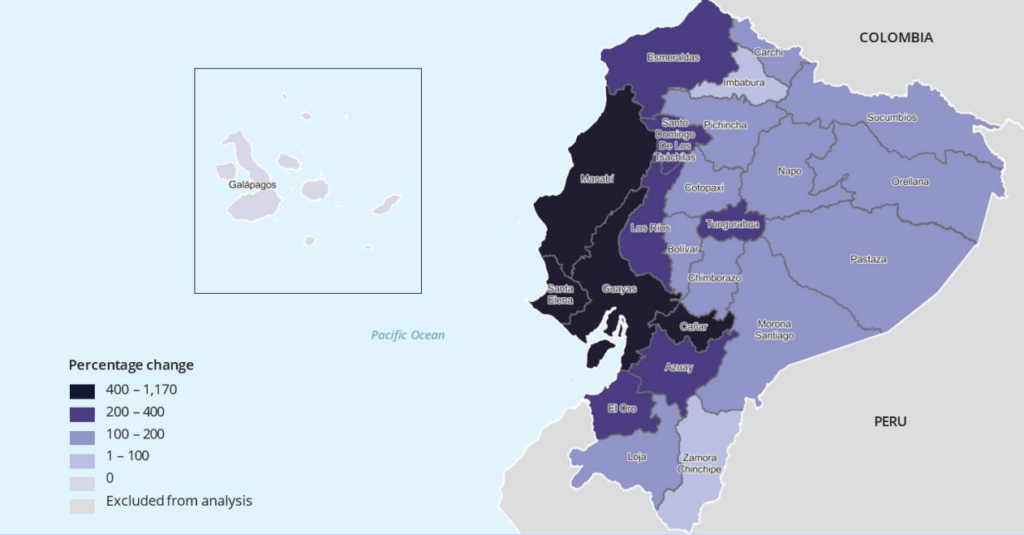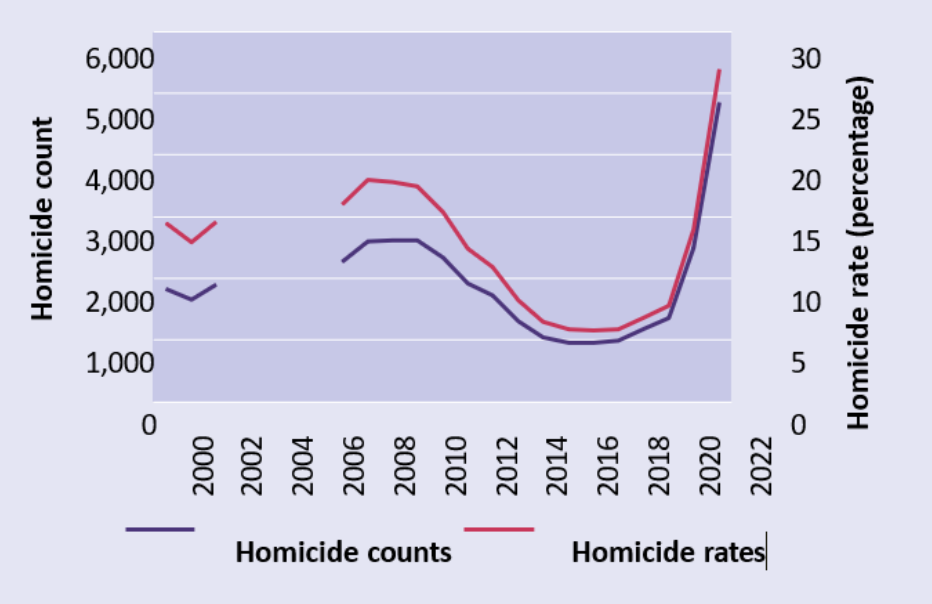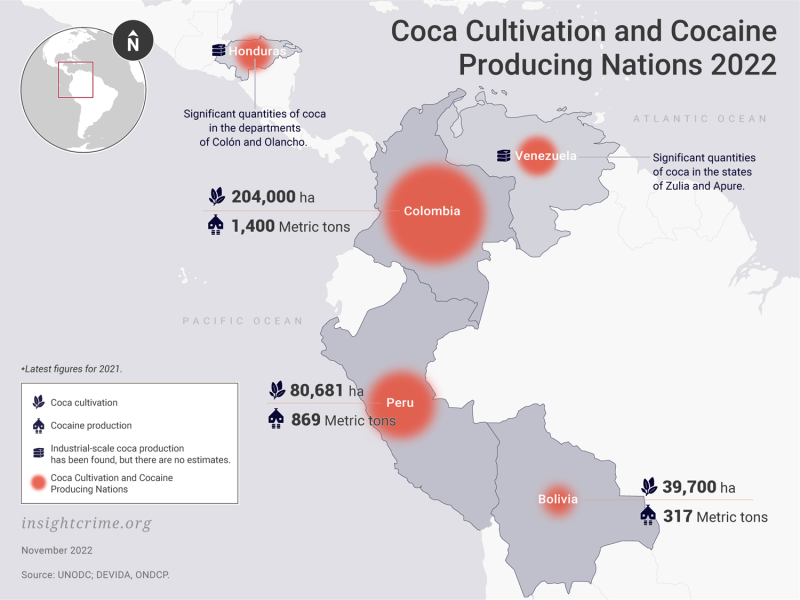Summary
The onset of 2024 brought a troubling security crisis to Ecuador, marked by the armed invasion of a university in Guayaquil and of a local TV station by individuals wielding guns and explosives. These incidents occurred merely two days after the leader of Los Choneros, a notorious criminal faction in the country, managed to escape from prison, where he was serving a lengthy 34-year sentence. This unsettling event is just one among several signals of impending turmoil across South American nations. Brazil, for instance, faces two major groups fighting for international connections in drugs producing countries in Latin America and national routes that allow drugs sales in the local market and the international one, particularly in Europe. While the crises in countries like Brazil, Venezuela, Ecuador, and Argentina may stem from different roots, the collective context underscores that South America is grappling with significant challenges in the security realms with one constant, the presence of organized crime linked to drug trafficking.
This Content Is Only For Subscribers
To unlock this content, subscribe to INTERLIRA Reports.
Ecuador’s Escalating Crisis: A Snapshot

In 2022, Ecuador ranked as the tenth most violent country in Latin America and the Caribbean by an InSight Crime’s rank, experiencing an alarming 82% increase in murders compared to the previous year. By 2023, it was on track to break into the top three, surpassing nations like Honduras, Venezuela, and Colombia, fueled by gang conflicts vying for control of the country’s drug business.
The crisis originated in prison riots and intensified following the premature dissolution of the National Assembly in May 2023. The situation took a darker turn with the assassination of presidential candidate Fernando Villavicencio on 9 August.
The crisis originated in prison riots and intensified following the premature dissolution of the National Assembly in May 2023. The situation took a darker turn with the assassination of presidential candidate Fernando Villavicencio on 9 August.
In January 2024, Ecuador faced a surge in gang violence in response to the new administration’s anti-crime measures. President Daniel Noboa declared a state of internal armed conflict, mobilizing armed forces to quell riots, attacks on security forces, and even an invasion of a live TV news broadcast by gangs. The president designated 22 criminal groups as terrorist organizations, urging a swift neutralization by the armed forces and police.

The conflict heightened following the disappearance of El Choneros gang leader Adolfo Macías, alias “Fito,” leading to a state of emergency and a 60-day military mobilization. This marks the first major security crisis for President Noboa, who had just assumed office, in November 2023.
Ecuador’s state of emergency occurs due to growing gang influence, drug trafficking, prison control, institutional corruption, and expansion into new criminal economies. However, President Noboa’s declaration of an armed conflict with gangs is unprecedented in the country’s history.
The dynamics of organized crime in Ecuador have evolved in recent decades. Once absent from discussions of cartels and organized crime, Ecuador’s strategic location between Peru and Colombia, the largest cocaine producers globally, has made it a crucial export hub. The country, squeezed between these major producers, has become a transshipment point for drugs bound for the USA and Europe, with internal factions associated with transnational crime dominating local prisons.

Rising global demand for cocaine, coupled with weak financial controls and the dollarization of the economy in 2000, have attracted Mexican cartels like Sinaloa and Jalisco Nueva Generación. The UN identifies Sinaloa Cartel as one of the world’s largest criminal organizations. Their activities in Ecuador and Colombia gave rise to the creation of violent local gangs like “Los Choneros” and “Los Lobos,” engaging in international drug trafficking, especially cocaine.
The financial crisis has exacerbated issues, making recruitment easier amid rising unemployment and deteriorating living conditions. Ecuador now stands as a vulnerable target for organized crime seeking less protected countries. The country’s predicament serves as a stark example of South American organized crime exploiting vulnerable nations.
The complex interplay of historical, economic, and geopolitical factors has plunged Ecuador into a severe crisis, necessitating a comprehensive and strategic response to address the multifaceted challenges it faces.
Chile’s Growing Security Concerns
Ecuador’s deteriorating security situation has raised concerns in Chile, where despite having a relatively low homicide rate compared to the region, the northern part of the country has witnessed a surge in crime and attacks against the Carabineros police force. Chileans, more than others in the region, express worry about the rising crime, attributing much of it to foreign-based groups like the Venezuela-based Tren de Aragua.
In 2022, a record 90.6% of Chileans believed that crime had increased, according to the National Urban Citizen Security Survey (ENUSC). This perception is particularly pronounced in the Arica, Parinacota, and Tarapacá regions, recording high rates of common crimes, including robberies, injuries, and homicides linked to organized crime. The overall homicide rate in Chile reached 6.7 per 100,000 inhabitants in 2022, a 46% increase from the previous year according to a study made by the InSight Crime.

The northern regions of Arica y Parinacota and Tarapacá, bordering Bolivia and Peru, have become hotspots for transnational crime, with lax customs controls enabling the infiltration of foreign criminal organizations, notably Tren de Aragua. These areas serve as lucrative drug routes for smuggling cocaine and marijuana from Bolivia into Chile, intensifying competition among criminal groups.
In response to the escalating violence, the Chilean government is taking measures, especially in the Arica y Parinacota region, which had the highest homicide rate in 2022, with 17.1 murders per 100,000 inhabitants, and 56.8% of killings linked to organized crime. However, the study highlights challenges faced by border authorities, including limited resources in terms of vehicles and technology, hindering effective control of the vast frontier.
Northern Chile faces an influx of foreign criminal actors, with a significant percentage of prisoners being foreign nationals, surpassing national averages. Insufficient government resources and limited public services in the region have allowed criminal groups to solidify their presence, taking advantage of the exodus of inhabitants and smuggling activities through unauthorized border crossings.
The intricate dynamics in northern Chile underscore the broader security challenges in the region, prompting the government to address issues like border control, resource allocation, and infrastructure development to curb the influence of criminal organizations and restore public safety.
Tren de Aragua: A Disturbing Trail of Violence
In Lima, a trans woman endured a horrifying fate, had been shot 31 times in March, with the murderer recording and sharing the brutal act on social media. In Arica, northern Chile, two bodies were exhumed in May, revealing they had been buried alive. In Bogotá, Colombia, the Attorney General’s Office confirmed a bar was used for dismembering people. Behind these heinous acts looms the Tren de Aragua, an organization originating from a construction union in Venezuela in 2009. Now, 15 years later, it has spread its influence across eight Latin American countries: Venezuela, Chile, Ecuador, Colombia, Peru, Bolivia, Brazil, and Panama.
Though Tren de Aragua cells in each country react to the local context, their regional growth has been neither uniform nor homogenous. While each cell may specialize in specific criminal activities based on local conditions, most share a common modus operandi and pyramid-type structure with clear leadership.
In her book, ‘Tren de Aragua: The gang that revolutionized organized crime in Latin America,’ Venezuelan journalist Ronna Rísquez outlines the transnational mega-gang’s extensive criminal portfolio. Their activities range from traditional crimes like extortion, kidnapping, robbery, fraud, illegal mining, and scrap metal smuggling to more unusual ventures, such as involvement in legal sports business, particularly those of Venezuelan baseball players signing with major league clubs in the United States.
Adapting to survive, the gang shifted its focus to other countries as Venezuela faced economic collapse. One of their notable skills is quickly identifying criminal business opportunities. When countries imposed restrictions on Venezuelan migration, Tren de Aragua guided migrants through irregular routes, controlling both human trafficking and illicit merchandise.
Between 2017 and 2018, the gang ventured into arms sales, selling weapons to Brazil’s First Capital Command (PCC), the largest and wealthiest in the country. A report from the State Public Ministry of Roraima confirms an alliance between the PCC and Tren de Aragua.
A portion of the gang’s profits flows into the Aragua Penitentiary Center, known as Tocorón prison, where the organization’s leader and founder, Hector Rusthenford Guerrero Flores, alias Niño Guerrero, is behind bars.
The jail doubled up as the headquarters of the Tren de Aragua, Venezuela’s most powerful transnational gang.

This expansion of organized crime across Latin America, marked by alliances, is evident in cases like the murder of Paraguayan prosecutor Marcelo Pecci, in Cartagena. Threatened by an organization operating between Paraguay and Uruguay, Pecci was later murdered in Colombia, with the involvement of Colombians and Venezuelans linked to the Tren de Aragua. While lacking military power like Mexican cartels or Colombian groups, Tren de Aragua has managed to establish a notable presence and control throughout South America.
Colombian Crime: Global Connections and Socioeconomic Factors
Colombians have long sought to overcome the trauma of drug trafficking, with the State strengthening its efforts. However, the country remains on high alert due to its history of armed conflicts, reaching a peak in the 1990s.
In October 2023, the father of Liverpool football player Luis Días was kidnapped by the National Liberation Army (ELN) guerrillas on the Venezuelan border, interrupting peace dialogues with the Colombian government. This kidnapping, labeled as an attempt to raise funds by the armed group, shed light on the specialization of Colombian criminals who have operated outside the country.
In another case, the murder of Ecuadorian presidential candidate Fernando Villavicencio in August involved suspects from Colombia. Researchers attribute the involvement of Colombians in crimes abroad to the country’s decades-long armed conflict involving guerrillas, paramilitaries, drug traffickers, and public forces.

The specialization of Colombian criminals is seen as a consequence of the six-decade conflict, with the global drug market, particularly cocaine, playing a significant role. Joana das Flores Duarte, a professor at the Federal University of São Paulo, links this specialization to cooperation between criminal groups from various countries, including Italy, the Netherlands, the United States, and Brazil. The war on drugs policy, largely sponsored by the Americans, is noted for contributing to the increased violence in this market.
Furthermore, Duarte points out a correlation between rising violence and socioeconomic challenges. High rates of unemployment, informality, lack of rights, and limited access to basic services contribute to insecurity and violence. Many individuals join criminal groups out of material necessity, creating a complex interplay between social issues and criminal dynamics.
Brazil’s Ongoing Security Challenges
Organized crime remains a challenge, all over Brazil. The biggest groups, founded in the richest states, Rio de Janeiro and São Paulo, developed direct alliances with the drug producers in the ’90s and in the beginning of the ’00. Thus, already reaching territories outside Brazil, at least to obtain the drugs they would resell to the local market and Europe and Africa.
Ten years later, the First Capital Command (“PCC”) and the Red Command (“CV”), the two largest criminal factions, entered a collision course. The prize was the dominance of one of Latin America’s main drug trafficking routes, which was controlled by Rafaat Jorge Toumani. After this central dealer was killed by the PCC in 2016, a war broke out. The groups were already expanding to other states; therefore, the reflexes were seen all over Brazil, with massacres inside many prisons and records of homicides in 2016 and 2017.
Currently, the expansion continues, and officially, they are active in at least 24 states and the Federal District. Drug trafficking already existed in smaller cities, but the PCC and the CV brought a large “scale” to the business, easy access to weapons, better organization, and rivalries with other groups.

They certainly understood the importance of being present in other nations developing various other criminal activities. For instance, it is reported that the PCC is present in 23 countries, besides Brazil. United States, Mexico, England, Holland, France, Switzerland, Portugal, and Lebanon are among the nations where it is present. The profit from international trade is huge. The PCC has achieved revenues of R$4.9 billion per year (USD1 billion), according to the Special Action Group for the Repression of Organized Crime (Gaeco), from the Public Ministry of São Paulo. The numbers refer to revenue from drug trafficking in São Paulo and the profit, above all, from cocaine sold to Europe. For its turn, the CV is present in at least five other nations: Bolivia, Peru, Paraguay, Venezuela, and Colombia.

Brazil has the third-largest prison population in the world, where prisoners live in poor conditions. The gangs used this fact to grow. By guaranteeing the safety and well-being of inmates, and making pacts with other local criminal organizations, PCC and CV managed to increase their numbers.
The power of these groups has reached such a level that they are capable of plunging a state into chaos. It was the case of the series of attacks seen in Rio Grande do Norte, in 2023. The escalation in violence last year also led Rio de Janeiro to another intervention by the Federal Government, which allocated the National Force and the Armed Forces in the state to help local police corporations.
The first indications of the international impact/presence of both gangs outside Brazil, begin near the borders, even before leaving the country. The crime rates in the cities near the borders, which are fundamental for routes used for smuggling drugs, firearms, and more, are quite above the national average. For instance, Caracaraí, in Roraima, in 2018, had a homicide rate of 93.8, much above the national average of 27.8. The region is affected by illegal mining and logging, which contributes more to the rise in violence.

The Brazilian drug market, driven by cocaine and marijuana use, poses significant challenges due to its vast coastline and difficult-to-patrol borders. The disappearance of traditional cartels has given way to less pyramidal actors like the PCC and the CV, making the tracking and tackling of organized crime more complex.
In summary, Brazil grapples with intricate challenges posed by organized crime, requiring sustained efforts to address root causes and ensure long-term stability.
Ameripol: Forging a United Front Against the Drug Trade
In the ever-evolving landscape of South American conflicts fueled by the surge in drug trafficking, the need for innovative regional security strategies has become paramount. Criminal factions effortlessly communicate across borders, exacerbating irregular conflicts, particularly in hotspots like Colombia and Brazil. As these conflicts unfold, the imperative to protect innocent civilians from becoming collateral damage in the war between states and armed groups has become apparent.
A shining beacon in this challenging scenario is Ameripol. While established in 2007, the Comunidad de Policías de América attained international recognition in 2023 with the signing of its treaty. Ameripol stands as a regional powerhouse committed to the exchange of police intelligence, executing collaborative operations, and providing comprehensive training for its members. With the active participation of 36 police forces from 30 countries across the Americas, along with 31 observer members representing international organizations and police forces from diverse continents, Ameripol is a force to be reckoned with.
This initiative stems from a critical need to foster a collective dialogue on defense and security. Operating within the framework of Union of South American Nations – Unasur, there’s a collective acknowledgment that the drug issue transcends borders and is, at its core, a public health challenge. Ameripol is an integral component of a broader regional strategy against drug trafficking. The South American Defense Council, under Unasur, aims to activate a cohesive response to combat drug-related challenges. Simultaneously, the South American Center of Strategic Studies for Defense endeavors to enhance monitoring and analysis of potential defense scenarios between nations, developing strategies to dismantle communication and trafficking networks fostered by criminal factions in the region.
The Ameripol also focuses its efforts on combating money laundering, recognizing the critical importance of financially stifling criminal groups. The organization seeks to strengthen cooperation between member countries, promoting best practices and joint strategies to weaken the financial structures of criminal organizations. Focusing on the fight against money laundering is essential to dismantle transnational networks and reduce the influence of these groups.
Crucially, this collaborative effort underscores a nuanced approach. It recognizes the limitations of relying solely on the Armed Forces and emphasizes the necessity of active cooperation and collaboration with civil society. In this way, Ameripol emerges not just as a collective of law enforcement agencies but as a beacon of hope, fostering unity and resilience in the face of a complex and dynamic security landscape.




